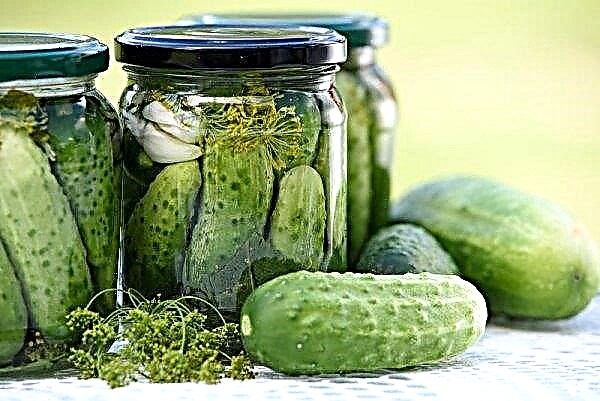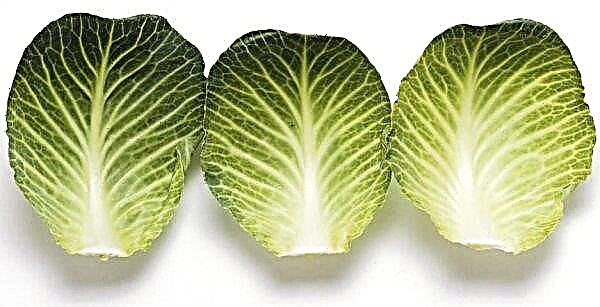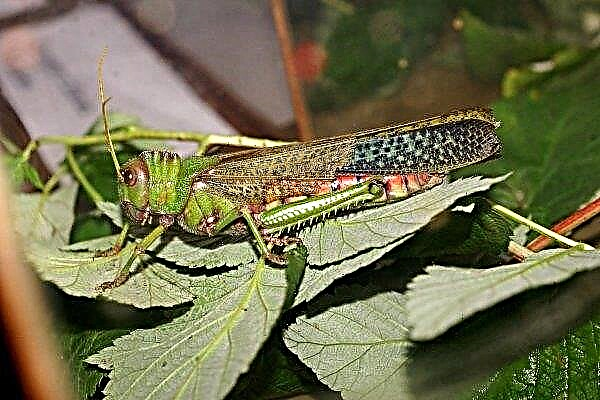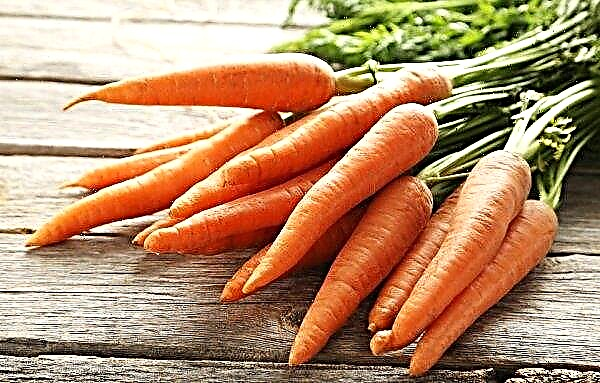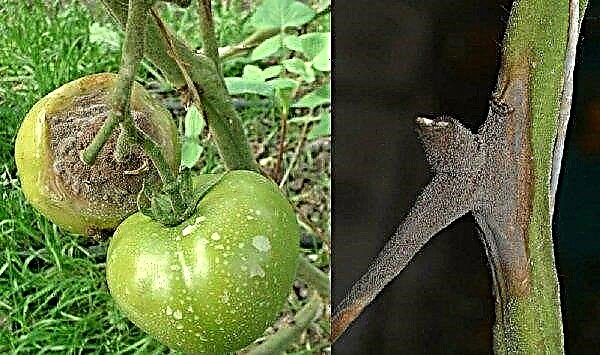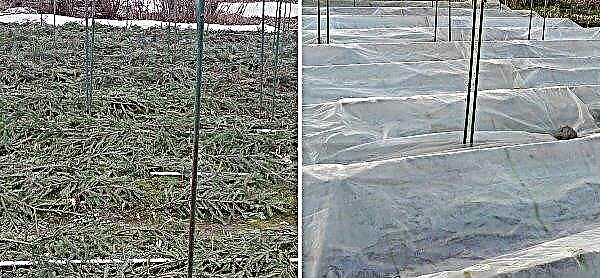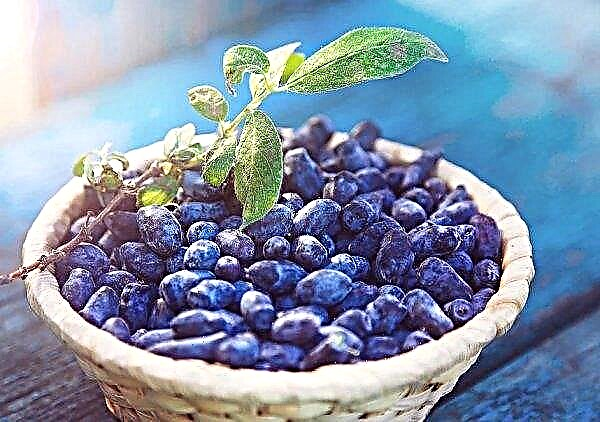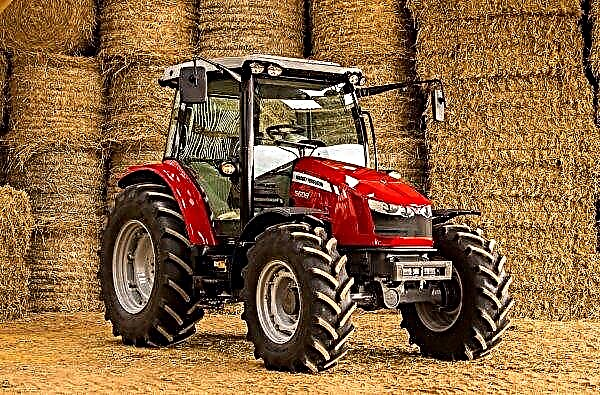Onions are the most important vegetable in cooking. It is used as a seasoning for various types of dishes to emphasize their taste and aroma. Because of this, everyone is trying to grow at least a little of this vegetable on their site. Among the existing varieties of culture, onions Stuttgarter Riesen are very popular. We will talk about him further.
Grade description
Onion Stuttgart Riesen bred by German breeders. The bulb has a rounded shape, slightly flattened in the upper part. The color of its outer scales is from milk to brown-yellow, inside it is white. One bulb can grow up to 150 g, and with good care and suitable conditions - up to 250 g. Its taste is quite sharp, rich, with a characteristic aroma.
- Positive qualities of the variety:
- excellent germination;
- high yielding;
- spicy but pleasant taste;
- good keeping performance.
- Disadvantages:
- because of the oblate shape, the onion is not very convenient to cut;
- the presence of a recess in the upper part of the bulb contributes to the development of putrefactive processes in wet weather;
- susceptible to peronosporosis.
Did you know? Scientific name of onion in Latin “Allium” comes from the Latin name for garlic, which originates in the Celtic word “all” (burning). According to another version, the name is associated with the Latin "halare" (smell).
Variety Stuttgart Riesen, in comparison with other varieties of culture, stands out for such qualities:
- resistance to most diseases;
- resistance to shooting;
- has a high concentration of vitamin C;
- universal to use;
- has a good yield.

Onion characterization and yield
The main characteristics of the variety:
- large-fruited;
- it tastes peninsular;
- to agricultural technology undemanding;
- matures early;
- stored for a long time in any form;
- You can grow winter onions.
The duration of the growing season for this variety is 115–120 days, if the vegetable is grown from seeds. When planting seeds, the ripening time is reduced by almost 2 times, up to 60–70 days. Being an unpretentious crop, onions Stuttgart Riesen even with poor care can yield about 5 kg per 1 m².
Selection of planting material
This onion can be grown both from seed and from seeds. Sevoc grown in Holland has the best quality. However, even after acquiring such a product, it must be carefully inspected for damage and signs of rot. The size of the fraction will suit any, but then the timing of planting will be different.
Important! Before planting, any seed should be soaked in a weak solution of potassium permanganate.
Small sowing should be planted in the fall - for winter cultivation. A large fraction is better to plant in the spring. Onion seeds are also called "chernushka". They need to be purchased only in specialized stores and be sure to pay attention to the expiration date.
Growing conditions
Onions love sunlight, so you need to form a bed under it in a well-lit place. This place should also be well ventilated. A vegetable is not afraid of a low temperature, but only if the decrease is gradual, without sharp jumps.
It is best to grow onions in a moderate temperature range. Does not tolerate a variety if moisture stagnates at its roots. Therefore, the soil should be well drained and make sure that no water collects in the spring in the spring. As soon as stagnation of water is detected, it is necessary to divert it immediately.
Soil and fertilizer
Variety Stuttgart Riesen prefers dry clay soils with neutral acidity. The soil should be loose, light, fertile. Before planting onions, peat and humus must be added to it to increase fertility.
Growing from seeds for seedlings at home
Usually, if the onions of the Stuttgart Riesen are grown from seeds, they are planted in open ground at the end of April. You can plant a vegetable in the winter, so that in the spring to get a crop. But some people prefer to first grow seedlings at home on the windowsill.
Seed preparation
The only thing that requires seed in preparation for sowing is disinfection. The potassium permanganate solution should be slightly pink, and the seeds are soaked in it for a day. Then they are dried on a battery.
Content and location
You can grow onions in deep seedlings. Ordinary juice packages (big ones) are also suitable: they need to cut a wide sidewall - you get a comfortable waterproof container with a lid. Before seedlings appear, the container must be placed under the battery. After germination, it should be moved to the rack and provide a 12-hour light day.
Seedling care
Seedlings moved to a lighted place should be watered regularly, as the topsoil dries up. The first top dressing is carried out 7 days after emergence. For these purposes, the liquid “Ideal” is used (2 caps per 1 liter of water). Subsequent nutrient additions should be done at 1 week intervals. The second time you should feed Kemira Wagon sprouts and subsequently alternate these 2 types of fertilizers.
If there is a glazed balcony, then after the temperature on it is established in the region of + 10 ° C, seedlings can be transferred there for hardening. Around the beginning of April, you can take out seedlings on the street for a while, always shading it. After 1 week of such procedures, you can begin to accustom plants to sunlight.
Transplanting seedlings into the ground
It is advisable to plant seedlings in open ground after the 20th of May, when the soil warms up well and the frost stops. The garden bed must be prepared in April. It must be done on a small elevation (10 cm), and the soil should be mixed with wood ash and compost. Seedlings are planted in a row with an interval of 10–13 cm, and between rows - 13 cm. Previously, you do not need to dig a hole, you can simply dig it with your hand during the planting process. After the procedure, the garden should be watered with Energen and covered with agrofibre for a week or two, so that the plants take root more quickly.
Seedlings are planted in a row with an interval of 10–13 cm, and between rows - 13 cm. Previously, you do not need to dig a hole, you can simply dig it with your hand during the planting process. After the procedure, the garden should be watered with Energen and covered with agrofibre for a week or two, so that the plants take root more quickly.
Important! To remove the covering material from the onion beds is necessary only in cloudy weather.
Care Methods
Caring for a crop is neither complicated nor troublesome. For onions, timely watering, fertilizing and fluffing up the top layer of the earth is important.
Watering
Plants are watered depending on soil conditions and weather conditions. On hot days, onions need frequent and plentiful irrigation (every 4-6 days), and on cloudy and damp days it is better to water as little as possible. Irrigation procedures should be carried out before the beginning of July and discontinued. This will allow the bulbs to dry. Watering is done in the evening and with warm water.
Soil cultivation and weeding
Loosening and removing weeds should be done regularly after irrigation procedures. It is necessary to fluff up a not very thick layer of earth, so as not to injure the bulb.
Top dressing
If the land on the plot is fertile, then the plant is rarely fed, and on poor soils, nutrients are applied once a month. The first top dressing is carried out 12-15 days after planting the culture in a permanent place. You can feed with both mineral complexes and organics.
When using organic fertilizers, it is extremely undesirable to use fresh manure, which can adversely affect the ripening of the bulb and can provoke the development of diseases. If the soil is poor in nitrogen, then you can water the bed with ammonia - it is able to destroy the emerging pests.
Pests, diseases and prevention
Variety Stuttgart Riesen is resistant to various diseases. When buying high-quality planting material, there will be no problems with cultivation. The only thing that can provoke the development of the ailment is poor care, namely stagnation of moisture, causing the bulb to rot. For preventive purposes, a pre-planting disinfection procedure will suffice. To discourage pests from the garden, you can plant dill nearby. A track of salt sprinkled in the aisle will drive off the onion fly.
Harvesting and storage
The signal that it is time to harvest is yellowing and withering of the pen. Cleaning takes place in dry, windy weather. If the soil is light (sandy loam or loamy), then the bulbs can be removed from the ground by hand, gently pulling the feather. When harvesting on heavy soil, it is advisable to dig the bulbs with a pitchfork at a certain distance from the row, and then carefully select them.
Harvested crops must be cleaned of dirt with hands and laid out in the sun to dry for 10-12 days. The fact that the onion is well dried will be indicated by its rustling when tedding. It is best to store the crop in wooden crates in dry, cool rooms with good ventilation. To extend the shelf life, the bulbs can be sprinkled with sand.

Useful Tips
Some general tips for growing onions:
- Avoid acidic and clay soils - on them the culture is not able to grow.
- After processing the seed with potassium permanganate, always dry it. In addition, cut off the tops from the northeast.
- Three times during the growing season, feed the plants.
- Manure should be used only rotted. Potassium chloride should be introduced only in the fall.
- It is best to harvest in late July before the rainy season begins.
- During storage of the crop periodically sort it out, picking up spoiled bulbs. The appearance of one rotten bulb very quickly provokes the development of putrefactive processes in the rest.
Did you know? The Romans believed that onions were able to increase the strength and courage of a warrior, so this vegetable must be included in the menu of soldiers.
Onions of the Stuttgart Riesen variety are perfect for growing in any climate zone. He is not afraid of the cold; he also transfers the heat successfully. He is not demanding in care and even with insufficient attention is able to give a good harvest.



